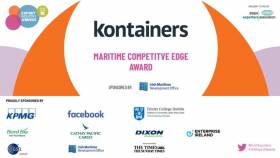Displaying items by tag: IEA Export Industry Awards
Kontainers - Winner 'Maritime Services Company of the Year' at Export Industry Awards
#Ports&Shipping - Kontainers, Dublin were the winner of the 'Maritime Services Company of the Year' at the annual Irish Exporters Association’s (IEA) Export Industry Awards.
The award sponsored by the Irish Maritime Development Office (IMDO), recognised the work of Kontainers, a digital partner in cutting edge ocean freight platforms, currently serving some of the biggest brands in shipping.
Portwest based in Westport, Co. Mayo, a manufacturer and distributor of work wear, safety footwear and peronal protection equipment, was the Overall winner of the Exporter of the Year Award 2018.
The prestigious award sponsored by the IEA, saw some 500 export industry professionals attend the gala awards ceremony last Friday at the Clayton Hotel, Burlington Road, Dublin. Also in attendence at the black tie event were diplomats representating over 25 embassies in addition to applicants and their guests.
The premier event now in its 18th year, has 12 categories that recognise the remarkable achievements of companies working in the export industry in Ireland.
Export Awards Maritime Services Company of the Year to ICG's Container & Terminal Division
#IEAexportAwards – At this year’s IEA Export Industry Awards, the winner in the category of Maritime Services Company of the Year, sponsored by the Irish Maritime Development Office went to Irish Continental Group’s Container & Terminal Division.
The division includes the intermodal shipping line Eucon as well ICG’s container terminals operated through their Dublin Ferryport Terminals (DFT) and in Belfast Container Terminal (BCT). Within the division, a fleet of time chartered container vessels ranging in size from 400 – 1,000TEU capacity (teu = twenty foot equivalent unit, the standard measure in the container industry).
Among the fleet, Elbetrader (pictured above) Afloat adds is currently docked in Rotterdam having sailed from ICG’s Dublin DFT terminal. The Cypriot flagged containership has a 974TEU capacity that includes reefer plugs for 170 – 110 located on deck with the balance of 60 stowed in the cargo hold within the ships overall 139m length.
This was the 17th year of the Export Industry Awards, the premier event of the Irish Exporters Association (IEA) that recognises the remarkable achievements of companies working in the export industry in Ireland. The Association assists its members to grow their exports to world markets.
The awards ceremony and gala dinner was attended by more than 500 export industry professionals took place on Friday at the Clayton Hotel Burlington Road, Dublin. There were 11 companies that won individual category awards across a range of sectors. Kildare based Irish Dog Foods was crowned the overall Exporter of the Year Award 2017 after winning the Medium Size Exporter of the Year Award category earlier in the evening.
Irish comedian Mario Rosenstock MC’d the black tie evening. Asides those from within the industry, guests included Mary Mitchell O’Connor TD, Minister of State at the Department of Education with special responsibility for Higher Education, representatives from over 25 Embassies, Secretary Generals and Awards sponsors.
The Export Industry Awards 2017 is supported by a number of corporate and industry sponsors. Platinum Sponsors: Bank of Ireland, Etihad Airways, KPMG, UCD Michael Smurfit Graduate School of Business and supportive Category sponsors Bord Bia, Dixon International Logistics, Enterprise Ireland, Facebook, GS1 Ireland, Irish Maritime Development Office and media partner The Times.
Export Industry Awards Winners Announced
#ExporterAwards – The Irish Exporters Association (IEA) annual Export Industry Awards gala dinner evening which attracted 500 guests was held recently in the National Convention Centre Dublin.
Minister for Communications, Energy & Natural Resources, Alex White, provided a keynote address to Ambassadors and Dignitaries from 24 Embassies in Ireland, while Ivan Yates presided as master of ceremonies.
Aerogen, a medical device and drug delivery company based in Dangan, Co. Galway, won the coveted Exporter of the Year 2014 award presented by hosts, IEA in association with sponsor HSBC. Aerogen also took home the Life Sciences Exporter of the Year Award.
The awards now in their 14th year included the category Medium Size Exporter of the Year which went to Athlone Extrusions with the category sponsored by Rosslare Europort.
The Awards recognise the achievements of companies working in the export industry. In total there are 11 companies which won individual category awards across a range of sectors.
To find out the names of the other award winners and more click HERE.





























































